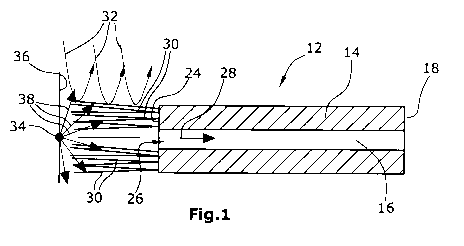Some of the information on this Web page has been provided by external sources. The Government of Canada is not responsible for the accuracy, reliability or currency of the information supplied by external sources. Users wishing to rely upon this information should consult directly with the source of the information. Content provided by external sources is not subject to official languages, privacy and accessibility requirements.
Any discrepancies in the text and image of the Claims and Abstract are due to differing posting times. Text of the Claims and Abstract are posted:
| (12) Patent Application: | (11) CA 3037084 |
|---|---|
| (54) English Title: | FILL PROBE ATTACHMENT HAVING ELONGATE GAS-GUIDING ELEMENT |
| (54) French Title: | ELEMENT RAPPORTE DE SONDE A REMPLISSAGE COMPORTANT UN ELEMENT ALLONGE DE GUIDAGE DE GAZ |
| Status: | Examination |
| (51) International Patent Classification (IPC): |
|
|---|---|
| (72) Inventors : |
|
| (73) Owners : |
|
| (71) Applicants : |
|
| (74) Agent: | PERRY + CURRIER |
| (74) Associate agent: | |
| (45) Issued: | |
| (86) PCT Filing Date: | 2017-09-18 |
| (87) Open to Public Inspection: | 2018-03-22 |
| Examination requested: | 2022-06-23 |
| Availability of licence: | N/A |
| Dedicated to the Public: | N/A |
| (25) Language of filing: | English |
| Patent Cooperation Treaty (PCT): | Yes |
|---|---|
| (86) PCT Filing Number: | PCT/EP2017/073404 |
| (87) International Publication Number: | EP2017073404 |
| (85) National Entry: | 2019-03-15 |
| (30) Application Priority Data: | ||||||
|---|---|---|---|---|---|---|
|
The invention relates to a sniffer probe (22) for a gas analyzer, wherein the sniffer probe (22) is designed to suction gas and can be connected to the gas analyzer and wherein the sniffer probe (22) has a sniffer tip (20) provided with a suction opening, such that gas is suctioned through the suction opening along a central perpendicular (28) to the suction opening, characterized in that the sniffer tip (20) has at least one elongate gas-guiding element (30), which is arranged substantially parallel to the central perpendicular (28) and distally protrudes beyond the suction opening.
L'invention concerne une sonde de reniflage (22) d'un analyseur de gaz, conçue pour aspirer du gaz et pouvant être reliée à l'analyseur de gaz. La sonde de reniflage (22) présente une pointe de reniflage (20) pourvue d'une ouverture d'aspiration de telle manière que du gaz est aspiré le long d'une médiatrice (28) de l'ouverture d'aspiration, à travers l'ouverture d'aspiration. L'invention est caractérisée en ce que la pointe de reniflage (20) présente au moins un élément (30) allongé guidant les gaz, disposé sensiblement parallèlement à la médiatrice (28) et faisant saillie de façon distale par rapport à l'ouverture d'aspiration.
Note: Claims are shown in the official language in which they were submitted.
Note: Descriptions are shown in the official language in which they were submitted.

2024-08-01:As part of the Next Generation Patents (NGP) transition, the Canadian Patents Database (CPD) now contains a more detailed Event History, which replicates the Event Log of our new back-office solution.
Please note that "Inactive:" events refers to events no longer in use in our new back-office solution.
For a clearer understanding of the status of the application/patent presented on this page, the site Disclaimer , as well as the definitions for Patent , Event History , Maintenance Fee and Payment History should be consulted.
| Description | Date |
|---|---|
| Amendment Received - Response to Examiner's Requisition | 2024-01-08 |
| Amendment Received - Voluntary Amendment | 2024-01-08 |
| Examiner's Report | 2023-09-19 |
| Inactive: Report - No QC | 2023-09-01 |
| Amendment Received - Voluntary Amendment | 2022-07-19 |
| Letter Sent | 2022-07-19 |
| All Requirements for Examination Determined Compliant | 2022-06-23 |
| Request for Examination Requirements Determined Compliant | 2022-06-23 |
| Request for Examination Received | 2022-06-23 |
| Common Representative Appointed | 2020-11-07 |
| Common Representative Appointed | 2019-10-30 |
| Common Representative Appointed | 2019-10-30 |
| Inactive: Notice - National entry - No RFE | 2019-03-28 |
| Inactive: Cover page published | 2019-03-25 |
| Application Received - PCT | 2019-03-21 |
| Inactive: IPC assigned | 2019-03-21 |
| Inactive: First IPC assigned | 2019-03-21 |
| National Entry Requirements Determined Compliant | 2019-03-15 |
| Amendment Received - Voluntary Amendment | 2019-03-15 |
| Application Published (Open to Public Inspection) | 2018-03-22 |
There is no abandonment history.
The last payment was received on 2023-08-16
Note : If the full payment has not been received on or before the date indicated, a further fee may be required which may be one of the following
Patent fees are adjusted on the 1st of January every year. The amounts above are the current amounts if received by December 31 of the current year.
Please refer to the CIPO
Patent Fees
web page to see all current fee amounts.
| Fee Type | Anniversary Year | Due Date | Paid Date |
|---|---|---|---|
| Basic national fee - standard | 2019-03-15 | ||
| MF (application, 2nd anniv.) - standard | 02 | 2019-09-18 | 2019-08-28 |
| MF (application, 3rd anniv.) - standard | 03 | 2020-09-18 | 2020-09-01 |
| MF (application, 4th anniv.) - standard | 04 | 2021-09-20 | 2021-08-26 |
| Request for examination - standard | 2022-09-19 | 2022-06-23 | |
| MF (application, 5th anniv.) - standard | 05 | 2022-09-19 | 2022-08-16 |
| MF (application, 6th anniv.) - standard | 06 | 2023-09-18 | 2023-08-16 |
Note: Records showing the ownership history in alphabetical order.
| Current Owners on Record |
|---|
| INFICON GMBH |
| Past Owners on Record |
|---|
| SILVIO DECKER |